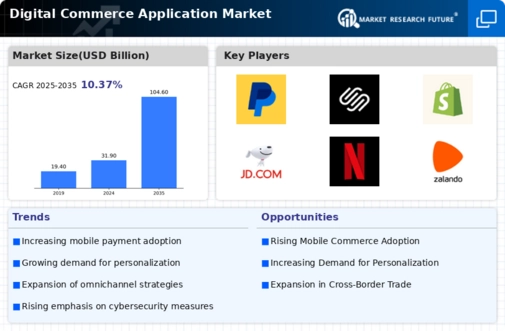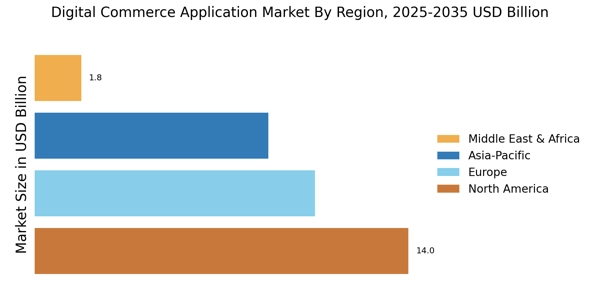Emergence of Social Commerce
The rise of social commerce is reshaping the Digital Commerce Application Market, as social media platforms increasingly serve as sales channels. With the integration of shopping features into platforms like Instagram and Facebook, consumers are now able to discover and purchase products directly through social media. This trend is supported by data indicating that social commerce sales are expected to reach 1.2 trillion dollars by 2025. As brands leverage social media for marketing and sales, the demand for digital commerce applications that support social commerce functionalities is likely to increase, further driving growth in the Digital Commerce Application Market.
Expansion of E-commerce Platforms
The Digital Commerce Application Market is experiencing a notable expansion of e-commerce platforms, which appears to be driven by increasing consumer demand for online shopping. As more businesses establish their online presence, the number of e-commerce platforms has surged, providing consumers with a plethora of options. According to recent data, the e-commerce sector is projected to reach a valuation of over 6 trillion dollars by 2024, indicating a robust growth trajectory. This expansion not only enhances competition but also encourages innovation within the Digital Commerce Application Market, as companies strive to differentiate their offerings and improve user experience.
Increased Focus on Sustainability
Sustainability is emerging as a key driver in the Digital Commerce Application Market, as consumers become more environmentally conscious. Businesses are responding by adopting sustainable practices and promoting eco-friendly products. Data shows that 66% of consumers are willing to pay more for sustainable brands, indicating a shift in purchasing behavior. This focus on sustainability is likely to influence the development of digital commerce applications that highlight sustainable practices and products, thereby aligning with consumer values and driving growth within the Digital Commerce Application Market.
Adoption of Omnichannel Strategies
The Digital Commerce Application Market is witnessing a significant shift towards omnichannel strategies, which integrate various sales channels to provide a seamless customer experience. Retailers are increasingly recognizing the importance of connecting online and offline touchpoints, leading to enhanced customer engagement and satisfaction. Data suggests that businesses employing omnichannel strategies can achieve a 91% higher customer retention rate compared to those that do not. This trend is likely to drive the demand for digital commerce applications that facilitate such integration, thereby propelling growth within the Digital Commerce Application Market.
Growing Demand for Personalization
Personalization is becoming a critical factor in the Digital Commerce Application Market, as consumers increasingly expect tailored shopping experiences. Businesses are utilizing data analytics and machine learning to understand consumer preferences and deliver personalized recommendations. Research indicates that 80% of consumers are more likely to make a purchase when brands offer personalized experiences. This growing demand for personalization is prompting companies to invest in advanced digital commerce applications that can analyze consumer behavior and provide customized solutions, thereby enhancing customer satisfaction and loyalty within the Digital Commerce Application Market.


















Leave a Comment